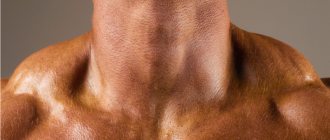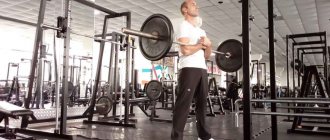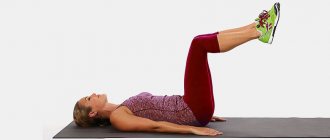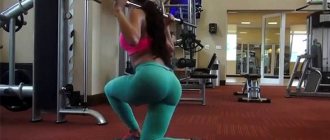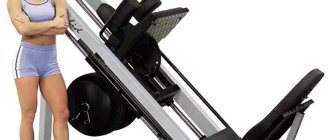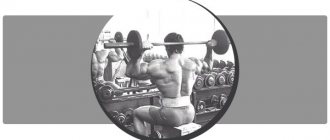Instead of reducing the volume of the hips, many modern women do exercises that help form elastic and toned buttocks. Moreover, even women somewhat deprived of nature try to make their curves more expressive with the help of numerous combinations of special exercises. To be healthy and fit, you need to develop 10 habits for a long and healthy life. And if, in addition to your buttocks, you are not satisfied with excess weight, read 10 rules that will help you lose weight without dieting.
Three muscle groups play a decisive role in the formation of toned and attractive buttocks: the gluteus maximus and medius muscles, as well as the muscles of the back of the thigh. Correct and systematic implementation of the exercises described in the article will give an effective load on these muscles and the result will not be long in coming.
So, let's look at 10 exercises for the above muscle groups that will make the lower part of an ideal body irresistible .
Gluteal bridge
This exercise specifically targets your glutes, and using dumbbells will help regulate the load. To perform the exercise, lie on the floor, bend your knees, pressing both feet to the floor, and lift your pelvis off the ground, being sure to keep your back straight. It was the straight back connecting the legs and shoulders lying on the floor that gave the exercise its name.
Raising yourself off the floor, freeze for a few seconds before the next repetition. When performed correctly, you lift your hips and pelvis with your gluteal muscles, the load on which will be felt in just a few seconds. If the exercise seems too easy, increase the load by placing dumbbells on your thighs and holding them with your hands.
Features of the exercise
The donkey exercise is aimed at creating volume and thickness in the calves. Its main feature is the absence of a compressive load on the spine, as a result of which it is used, among other things, by athletes with back injuries.
You may be interested in:Belly dancing: benefits and harms, effects on the body, reviews
The main load is received by the triceps muscles of the leg, combining the lateral and medial heads, as well as the soleus muscle. During the exercise, the tibialis anterior muscle is partially involved.
Donkey kicking
And while kicking like a donkey may make you feel a little stupid, believe me, it's worth it! To perform this exercise, get on all fours with your arms and thighs straight and perpendicular to the floor. Then, in a slow, controlled movement, move one leg back, using your abdominal muscles to help maintain balance. In this case, it is the controlled movement of the leg back, and not the random dangling of it, that will give the necessary load on the muscles. Do not forget to also change your leg after several approaches, providing load to the second buttock.
Romanian deadlift
Anyone who has become concerned about the appearance of their buttocks and thighs will sooner or later encounter deadlifts - one of the most revered exercises in the entire fitness industry. The Romanian deadlift is a little more difficult than the regular deadlift, but it certainly gives great results. Stand straight, feet shoulder-width apart and knees slightly bent, hold a barbell or dumbbells in your hands.
Then, being sure to keep your back and arms straight, lower and raise the barbell. Many people think that deadlifts put the bulk of the load on the arms, but believe me, if your back and arms are straight, you will feel the tension in your hips and buttocks after lifting the weight just a few times.
Sumo squats
Sometimes even a slight adjustment in the technique of performing an exercise allows you to load a completely different muscle group . Sumo squats are just such a type of squats. The difference between this squat and a regular one is that the feet are positioned at a width significantly greater than the width of the shoulders, and they are turned outward.
When performing such a squat, you bend your knees not forward, but to the sides, as if you were sitting on and getting up from a chair. Any squats load the muscles of the thighs and buttocks, but sumo squats focus the load on the buttocks and inner thighs.
Execution technique
Initial position:
- Stand with your toe on a flat footrest, lower your heel beyond it and rest your lower back against a special pillow.
- Straighten your legs, but maintain a slight angle at the knee joint - 1-2°.
- Grab the handrails with your elbows bent and your forearms resting on the support.
- Slowly, as you inhale, lower your heels down, stretching the muscles of your lower leg.
Movement:
- As you exhale, powerfully push yourself up onto your toes.
- In the upper position, maintain a one-second static pause.
- As you inhale, lower your heels down over the edge of the platform.
- Complete the planned amount of work.
Attention!
[su_list icon=”/wp-content/uploads/2017/01/Delete-64-1.png” icon_color=”#f55254"]
- Don't push your knees in while doing lifts. This puts weight on the knee joint and threatens injury.
- Do not perform the exercise at a fast pace or jerk. The ankle is quite easy to injure, and any forced movements and sudden contractions only increase this likelihood.
- Do not allow the toe to slide off the support pad. This can cause damage to the ligaments and tendons of the ankle.
- Do not reduce the range of motion. The effectiveness of working out the legs directly depends on this.
Recommendations!
[s[su_list icon=”/wp-content/uploads/2017/01/Checked-50-1.png” icon_color=”#f55254"]p>
- Raise your toes as high as possible to achieve effective contraction of the calf and soleus muscles.
- Perform movements in a measured and controlled rhythm.
- Spend a little more time on the rise than on the negative phase.
Execution options
[su_[su_list icon=”/wp-content/uploads/2017/01/Barbell-50-1.png” icon_color=”#f55254"]
- Donkey exercise with a partner or a weight on your back. This variation is suitable for those who do not have a target simulator in the gym. Take a similar inclined position with your hands resting on horizontal supports and stand with your toes on a hill using barbell discs or a step platform. The role of “weight” in this case will be played by the partner himself, sitting on the hip joint of the exerciser. You can also use a weight placed below the base of your lower back and held by a partner.
- Exercise Donkey without weight. Perform the calf donkey exercise without weights if you are still a beginner or need to practice your technique.
Step up
Many people perform step-up in the gym using aerobics blocks, but even if you don’t have such an opportunity, this useful exercise remains one of the simplest - you can use steps, a bench and, in general, anything to do it, having a difference in height.
You simply stand in front of the step/bench and place one foot on it. Then you lift your entire body using the muscles of this leg until it is completely level, and similarly lower yourself back to the floor and start from the beginning, periodically switching legs. This exercise is one of the easiest; if you are able to walk up the stairs, then you can do it without any problems.
The donkey himself
The exercise is considered strength, with weights, the load should be approximately equal to 40-50 kilograms. The secret is that it is not the spine or lower back that is loaded, but the main emphasis is on the legs. So watch how it's done.
- Stand with both feet on a low bench (15-20 centimeters), then the range of movements increases. If you stand on a flat floor, it is much shorter. It is recommended to do three options for placing your feet: parallel, toes inward, toes to the sides. Pull your heels down, let them remain suspended.
- Leaning on a horizontal surface, lean forward strictly parallel to the floor. The hip joints should be perpendicular to the toes of the feet.
- Place a weight on the hip joint - this could be your partner, a friend of a good size. He should sit like a stone, not leaning either to the left or to the right. Your knees remain level, but slightly bent. You need to look straight ahead.
- You should rise on your toes as you exhale, hold for a couple of seconds, stretch, stretch, and while inhaling, lower yourself.
- And so, according to the classics, three approaches of 15-20 times.
A funny exercise, especially if you look at it all from the outside, lifts the mood of everyone present in the gym and relieves tension. And such training will only benefit you. Be sure to take before and after photos of your feet.
If for some reason you are left without a partner, he can be replaced by your child, whom you accidentally or on purpose (let him study!) take with you to the gym, or, at worst, some heavy object, exercise equipment. You just need to fasten it securely.
Do you understand how to secure it? Doesn't kick??? Keep training. The donkey exercise can be varied, for example, by doing calf raises with dumbbells in your hands or sitting with dumbbells on your knees.
In order to understand the differences between animals, it is necessary to consider each of them in detail.
A mule is a mammal that was created by crossing a mare with a donkey. This animal has a number of the following differences:
- Its body size is similar to that of a horse.
- The animal's head resembles that of a donkey
- Mules are distinguished by strength and endurance
- Animals can take part in races
- Males cannot give birth to offspring
- The maximum lifespan of mules reaches 40 years
- They are easy to breed on a farm, since the animals eat most types of feed and have strong immunity
They have the following characteristics:
- The height of draft mules does not exceed 140 cm, while pack mules reach 160 cm
- The first type weighs about 400-600 kg, and pack ones only 300-400 kg
- Traction force as a percentage of total body weight – 18-20%
- Animals over 4 years old are allowed to work with heavy weights
- All males must be castrated as they are infertile when active.
Read more: DIY coordination staircase - All about stairs
It is customary to practice mule farming in the following regions:
- Balkan countries
- North and South America
- Africa
- Asia
- Middle Eastern countries
All representatives are characterized by the following features:
- Donkeys can live from 25 to 35 years
- Growth rates vary depending on the breed (from 90 to 160 cm)
- It is permissible to use animals to their full potential upon reaching the age of three.
- Donkeys are trained to work from the age of 2
- Animals must be raised with care, as they cannot tolerate low temperatures and dampness.
- Only grass and shrubs are used as food
- The color of the coat depends on the breed of the animal
- Males can have offspring
Regarding donkeys, it is worth saying that this was originally the name given to wild donkeys that were tamed by humans in the process of evolution. These animals are of African origin, since similar attempts used in relation to representatives of the Asian steppes (kulans) were unsuccessful.
Thus, the following conclusions can be drawn:
- Donkey and donkey are representatives of the same animal class and species
- The mule was created by crossing a female horse and a male donkey.
- Donkeys can be wild or domestic
- Male mules cannot reproduce
A donkey differs significantly from a mule in external features. In order to distinguish these representatives, it is necessary to take into account the most pronounced features of each of them. For example, a mule is characterized by:
- The size and shape of the body resembles a horse
- The voice of a mule is similar to the voice of a horse
- The shape of the hooves, hips and head is similar to their structure in a donkey.
- The color resembles the color of the coat of horses
- Mules have 6 lumbar vertebrae
- Animals are heavy and can reach 160 cm in height
- Animals will inherit the mane, neck shape, tail and bangs from the mother (mare)
Characteristics of animals
Donkeys and donkeys are characterized by the following features:
- Number of lumbar vertebrae – 5
- Animals weigh less
- Certain breeds are shorter in stature than mules
- Coat color may vary depending on their breed
- There is always a tassel at the end of the tail
- A donkey has slightly longer hair than a donkey.
These animals have some differences and they are expressed in several features. For donkeys and donkeys there are characteristic differences in the following categories:
- Gender (donkey is male and donkey is female)
- Height and weight (males are larger and heavier)
- Lifespan (males live longer)
Animal differences
The mule differs from donkeys and donkeys in the following factors:
- Great endurance
- High efficiency
- Increased noise level (donkeys and donkeys are less noisy)
- Weight and height (mules are significantly heavier and often taller)
- Increased immunity stability
- Ability to adapt to any weather conditions
- Unpretentiousness in food (mules can eat almost any food)
- Reproductive function (male mules are sterile, unlike donkeys)
- Body structure and shape
- Coat and coat colors (mules are more similar to horses)
- The need for castration of males (donkeys without the necessary indications do not need to be deprived of the opportunity to reproduce offspring)
- Lifespan (mules live longer)
- Possibility of training a mule to work from childhood
Based on these factors, we can summarize: the donkey and the donkey do not have multiple differences, since these animals belong to the same class and species. However, a mule has more individual characteristics because it contains horse genes in its DNA. It was this factor that became decisive in the breeding of offspring, because thanks to it the animal became much larger, more resilient and stronger than its father (donkey).
Both donkeys and donkeys are characterized by:
- Stubbornness
- Clumsiness
- Low noise level
- Low movement speed
- Laziness
- Calm
- Patience
- Pickiness in food and living conditions
Often this animal can stop halfway for no apparent reason. In such a situation, the owner is unlikely to be able to force the donkey or donkey to continue moving. But, despite this fact, they are capable of covering long routes and helping to transport large cargo.
Let's also say a few words about mules. Since mules have the genes of a horse and a donkey, they can inherit certain character traits.
Animal stubbornness
As a rule, representatives of these animals are characterized by:
- Agreeableness
- Caution
- High degree of performance
- Loudness
- Shyness
- High movement speed
Laziness and stubbornness may also be inherent, but only in the case of aggressive behavior of the owner. Also, mules often participate in sports races, so they can be trained from an early period, but it is important not to show aggression.
Unambiguously answer the question: “Who is smarter than a donkey, a donkey or a mule?” - impossible. All representatives of these animals have both positive and negative aspects of behavior. And donkeys and donkeys are equally stubborn. Although females are more often lenient and more susceptible to the influence of their owner.
Reverse lunges
Everyone must choose the most suitable and effective exercises for themselves. Reverse lunges, for example, are a good alternative to classic lunges for people with problem knees, as they place significantly less stress on them. To perform the exercise, stand straight with your feet shoulder-width apart and toes forward.
Then take a big step back with your left foot and bend both knees until your right thigh and left ankle are parallel to the floor. Using both legs, you return to the starting position. After repeating the lunge several times, change legs and continue working.
Jump Squats
This effective exercise combines the work of the front and rear thigh muscles, as well as the gluteal muscles and cardio load .
To perform it, stand straight, feet shoulder-width apart, chin raised. Do a regular squat, bending until your thighs are parallel to the floor, and then transfer your weight to your heels and push off with both legs as hard as you can, jumping as high into the air as possible. After landing, immediately squat down and start over.
Place in the training program
It is recommended to perform the donkey exercise at the end of a leg workout or as part of training other muscle groups.
The basic scheme for training the calf muscles is to perform a large number of lifts - in the range of 12 to 20 repetitions and from 3 to 5 approaches. To prevent a plateau effect, you should occasionally stress your shins by increasing the load while reducing the number of repetitions.
To optimize the training process, try to adhere to the following recommendations:
- Take a rest day between workouts. It is most effective to do three workouts per week: Monday, Wednesday and Friday.
- Work your calves during the rest period between sets. Don't put off training your calf muscles until the very end when you're exhausted. Train them during rest periods during your main workout.
- Do some stretching. Don't forget about this important element of training. Stretching will allow you to work the target muscles and prepare them for more intense strength loads. Stretching exercises will help prevent muscle and ligament sprains and also increase their flexibility and elasticity.
Step Lunge
Similar to the reverse lunge, the step lunge is a variation of the classic exercise. To perform it, stand straight with your feet together (not shoulder-width apart). Take a big step forward and squat, while the knee of the front leg should remain above the foot, and the knee of the back leg should lower to the ground without touching it.
Then return to the starting position and take a step with the other leg, repeating the movements as needed. To engage the upper body in the exercise and increase the load, you can hold dumbbells in both hands, keeping your arms straight or bending them at the elbows, providing a comprehensive toning load for the body.
What are effective exercises for calves?
Calf exercises are varied. But there are a few main ones:
1. Standing calf raise; 2. Seated calf raise; 3. Toe press in the simulator; 4. Standing toe press in a machine, standing calf raise in a machine; 5. Raising on your toes, bending your knees; 6. "Donkey".
These are exercises for the back of the lower leg. Here are some exercises for the front of the lower leg:
1. Concentrated pull of the toe towards you; 2. Raising the torso with the strength of the anterior muscles of the lower leg, hooking the socks to the belt while hanging.
I can say from myself that the anterior muscles of the lower leg are practically invisible, and in life they are almost not used. Therefore, you can pump them up within 2-3 weeks without straining. Just a concentrated pull of the socks towards you with a delay at the top point is enough.
Anatomical atlas
The first step is to understand which calf muscles are involved in this exercise.
Therefore, all attention to the following image (clickable):
Muscle work in the exercise itself:
Now let's compare standing calf raises and donkey calf raises and find out which is the best choice for building massive calves (clickable):
The muscles involved in both exercises are the same, but the donkey provides a greater range of motion, allowing for more emphasis on the calves. Standing calf raises place stress on the shoulders and put excessive compressive force on the spine. With the burro lift, the load is placed directly under the hips and bypasses the spine, reducing the risk of injury to the spine.
So, it's time to talk about execution technique, let's go.
Execution technique
The donkey exercise, its classic version, is:
The main effect of the exercise is the development of the thickness of the calf muscles; they look simply huge when viewed from the side. The technique consists of sequentially performing the following steps:
№1.
You will need a flat, hard surface with a raised platform installed on it (this can be a strong wooden platform of 15-20 cm) and a support point in the form of an inclined frame (horizontal surface).
№2.
Place your toes on the platform, lean forward and rest your elbows on the frame/bench/table. Make sure your hip joints are directly under your toes.
№3.
Ask your friend (or 1 or 2 girls from the audience to suit your taste) to ride you. Those. your partner should climb onto your back and securely stay there. Make sure that the weight of the “weight” is on your legs and not on your lower back.
№4.
Lower your heels down under control (feel the muscle stretch), then rise powerfully to full contraction and hold at the top of the amplitude for 1-2 seconds.
In motion, all this pornography beauty called, donkey exercise, looks like this:
Subtleties and secrets
Small tips to keep in mind:
- Breathing technique: inhale – lower, exhale – rise;
- Socks can take 3 positions: straight, outward, inward - it all depends on the area of working the calves;
- “Do not lock” the knee joint (keep it slightly bent).
- The knees are motionless throughout the entire movement;
- Get as high as possible at the top.
- Partner's weight - focus on 3 sets and the number of repetitions is 15-20.
- Cheating in this exercise is when your partner rides you like a camel.
By placing your feet on the platform in different positions (see image), you will shift the emphasis of the load on your calves, i.e. place more load on the outer/inner calf:
You should not think that girls cannot (because they need to put someone on their back) do this exercise. Ask your friend to hold a platform with a weight installed on it (2) or, sometimes, there is a special “donkey” exercise machine in the gym (1); in extreme cases, you can run to kindergarten for weights in the form of a child (3).
Here is a simple but very useful exercise for developing the calf muscle, use it for your health.
Exercise with a fitness ball
For this exercise, it’s good to have a fitness ball, but if you don’t have one, then ingenuity, as always, will come to the rescue. If you've already done the glute bridge, you'll master this new exercise in a matter of seconds. To do it, lie on the floor and place your feet on a fitness ball (or any elevated surface, such as the edge of a bed), then lift your hips up until your entire body is aligned, as in a glute bridge, and lower them back.
If desired, the exercise can be made more difficult by rolling the ball back and forth a little while raising your hips . To do this, however, you will need a real fitness ball, unless, of course, your buttocks are already strong enough to move the mattress on the bed!
Squats
To perform classic squats, you stand straight, feet shoulder-width apart, toes forward, and lower yourself down as if you were sitting down on a chair. Your knees should remain above your feet and your thighs should be parallel to the floor, after which you rise back and that's it - the squat is done! This classic exercise can be varied by placing your feet narrower or wider, using only your weight or squatting with a barbell on a special stand, the options are endless!
Just include squats in your regular exercise routine and consider that you have already come a good part of the way to toned sexy buttocks.

